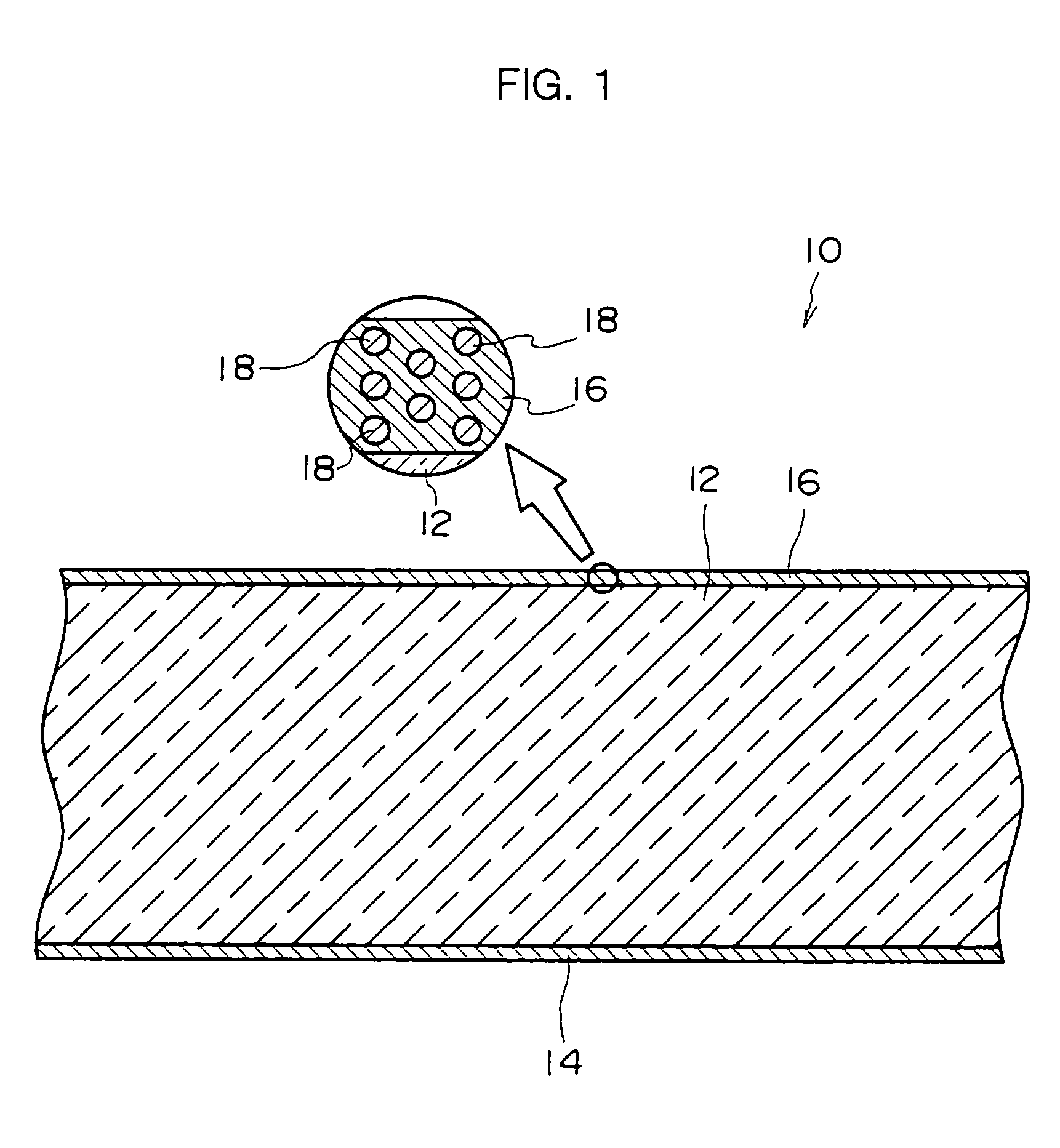Reflecting mirror
a technology of reflecting mirror and mirror, which is applied in the field of reflecting mirror, can solve the problems of dirty surface of reflecting mirror and rain exposure of reflecting mirror, and achieve the effects of reducing the light transmittance of the transmittance changing part, and improving antidazzle
- Summary
- Abstract
- Description
- Claims
- Application Information
AI Technical Summary
Benefits of technology
Problems solved by technology
Method used
Image
Examples
first embodiment
[0054]FIG. 1 shows a schematic cross-sectional view of a reflecting mirror 10 of the present invention.
[0055]As shown in FIG. 1, the reflecting mirror 10 comprises a glass substrate 12 as a substrate. A reflecting film 14 is formed on the back surface of the glass substrate 12.
[0056]For example, the reflecting film 14 is made of chrome or an alloy essentially consisting of the chrome. At least the surface of the side of the glass substrate 12 of the reflecting film 14 formed on the glass substrate 12 has sufficient luster, and high reflectivity. Therefore, when light entering from the surface side of the glass substrate 12 transmits in the glass substrate 12 and reaches the back surface of the glass substrate 12, the light is reflected by the reflecting film 14. The light reflected transmits in the glass substrate 12 again, and moves toward the surface side of the glass substrate 12.
[0057]In the embodiment, the reflecting film 14 is made of chrome or an alloy essentially consisting ...
second embodiment
[0078]FIG. 4 is a cross-sectional view showing a schematic structure of a reflecting mirror 30 of the invention.
[0079]As shown in FIG. 4, the reflecting mirror 30 comprises a conductive reflecting film 32 as a reflecting film in place of the reflecting film 14. The conductive reflecting film 32 is made of aluminum or an alloy essentially consisting of the aluminum. The surface of the side of the glass substrate 12 of the conductive reflecting film 32 has sufficient luster and high light reflectivity as well as the reflecting film 14 of the first embodiment.
[0080]An electrochromic film 34 which is a whole solid thin film as a transmittance changing part is formed on the back surface of the glass substrate 12 of the reflecting mirror 30 (the opposite side to the photocatalytic hydrophilic film 16).
[0081]The electrochromic film 34 comprises a transparent electrode film 36. The transparent electrode film 36 is made of an oxide of an alloy of indium and tin, so-called “ITO”. Also, the tr...
third embodiment
[0094]Next, the invention will be described.
[0095]FIG. 5 shows a schematic cross-sectional view of a reflecting mirror 60 of the third embodiment of the invention.
[0096]As shown in FIG. 5, in the reflecting mirror 60, an electrochromic layer 62 as a transmittance changing part is formed between the reflecting film 14 and the glass substrate 12.
[0097]The electrochromic layer 62 comprises a transparent glass substrate 64. A pair of transparent electrode films 36 are formed on the surface of the glass substrate 64 so as to oppose each other in the thickness direction of the glass substrate 64 (the surface of the side of the glass substrate 12).
[0098]The transparent electrode films 36 are connected to the power supply 40 through the switch 38, and voltage can be applied from the side of one transparent electrode film 36 or the side of the other transparent electrode film 36 by operating the switch 38 appropriately.
[0099]For example, a seal 66 is formed between one transparent electrode ...
PUM
| Property | Measurement | Unit |
|---|---|---|
| Fraction | aaaaa | aaaaa |
| Fraction | aaaaa | aaaaa |
| Thickness | aaaaa | aaaaa |
Abstract
Description
Claims
Application Information
 Login to View More
Login to View More - R&D
- Intellectual Property
- Life Sciences
- Materials
- Tech Scout
- Unparalleled Data Quality
- Higher Quality Content
- 60% Fewer Hallucinations
Browse by: Latest US Patents, China's latest patents, Technical Efficacy Thesaurus, Application Domain, Technology Topic, Popular Technical Reports.
© 2025 PatSnap. All rights reserved.Legal|Privacy policy|Modern Slavery Act Transparency Statement|Sitemap|About US| Contact US: help@patsnap.com



